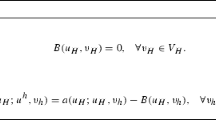Abstract
In this paper, we propose, analyze, and numerically validate a goal-oriented adaptive two-grid finite-element method for second-order semilinear elliptic problems. In this method, the \((k+1)\)th and the kth adaptive meshes are considered as the fine and coarse meshes. The proposed algorithm requires a one-step Newton correction for the primal problem, and applies a special treatment to the reaction term for the dual problem, which in turn leads to linear discrete primal and dual problems having the same coefficient matrix. Therefore, this algorithm is more efficient than goal-oriented adaptive finite-element methods based on the classical Newton iteration. We prove contraction properties of the primal quasi-error and the combined primal-dual quasi-error, from the latter of which the convergence theory of the proposed method is established, up to higher order primal \(L^2\)-norm error terms implicitly requiring the initial mesh to be sufficiently fine. Some numerical examples are shown to illustrate the effectiveness and efficiency of this algorithm.




Similar content being viewed by others
References
Axelsson O, Barker VA (2001) Finite element solution of boundary value problems: theory and computation. Soc Ind Appl Math 20:20
Bangerth W, Rannacher R (2013) Adaptive finite element methods for differential equations. Birkhäuser, Basel
Becker R, Innerberger M, Praetorius D (2021) Optimal convergence rates for goal-oriented FEM with quadratic goal functional. Comput Methods Appl Math 21(2):267–288
Becker R, Rannacher R (2001) An optimal control approach to a posteriori error estimation in finite element methods. Acta Numer 10:1–102
Bi C, Wang C, Lin Y (2018) A posteriori error estimates of two-grid finite element methods for nonlinear elliptic problems. J Sci Comput 74(1):23–48
Brandts JH, Korotov S, Křížek M (2008) The discrete maximum principle for linear simplicial finite element approximations of a reaction–diffusion problem. Linear Algebra Appl 429(10):2344–2357
Brenner S, Scott R (2007) The mathematical theory of finite element methods, vol 15. Springer, Berlin
Bürg M, Nazarov M (2015) Goal-oriented adaptive finite element methods for elliptic problems revisited. J Comput Appl Math 287:125–147
Cascon JM, Kreuzer C, Nochetto RH, Siebert KG (2008) Quasi-optimal convergence rate for an adaptive finite element method. SIAM J Numer Anal 46(5):2524–2550
Ciarlet PG, Raviart PA (1973) Maximum principle and uniform convergence for the finite element method. Comput Methods Appl Mech Eng 2:17–31
Ciarlet PG (2002) The finite element method for elliptic problems. Soc Ind Appl Math 20:20
Feischl M, Praetorius D, Van der Zee KG (2016) An abstract analysis of optimal goal-oriented adaptivity. SIAM J Numer Anal 54(3):1423–1448
Fidkowski KJ, Darmofal DL (2011) Review of output-based error estimation and mesh adaptation in computational fluid dynamics. AIAA J 49(4):673–694
Giles MB, Süli E (2002) Adjoint methods for pdes: a posteriori error analysis and postprocessing by duality. Acta Numer 11:145–236
Heid P, Wihler TP (2020) Adaptive iterative linearization Galerkin methods for nonlinear problems. Math Comput 89(326):2707–2734
Holst M, Pollock S (2016) Convergence of goal-oriented adaptive finite element methods for nonsymmetric problems. Numer Methods Partial Differ Equ 32(2):479–509
Holst M, Pollock S, Zhu Y (2015) Convergence of goal-oriented adaptive finite element methods for semilinear problems. Comput Vis Sci 17(1):43–63
Guanghui H, Meng X, Yi N (2016) Adjoint-based an adaptive finite volume method for steady Euler equations with non-oscillatory k-exact reconstruction. Comput Fluids 139:174–183
Innerberger M, Praetorius D (2021) Instance-optimal goal-oriented adaptivity. Comput Methods Appl Math 21(1):109–126
Kerkhoven T, Jerome JW (1990) \(L_\infty \) stability of finite element approximations to elliptic gradient equations. Numer Math 57(6–7):561–575
Key K, Ovall J (2011) A parallel goal-oriented adaptive finite element method for 2.5-D electromagnetic modelling. Geophys J Int 186(1):137–154
Korotov S, Neittaanmäki P, Repin S (2003) A posteriori error estimation of goal-oriented quantities by the superconvergence patch recovery. J Numer Math 11(1):33–59
Lakshmikantham V, Vatsala AS (1977) Elliptic partial differential equations of second order. Springer, Berlin
Larsson F, Hansbo P, Runesson K (2002) Strategies for computing goal-oriented a posteriori error measures in non-linear elasticity. Int J Numer Methods Eng 55(8):879–894
Li Y, Zhang Y (2021) Analysis of adaptive two-grid finite element algorithms for linear and nonlinear problems. SIAM J Sci Comput 43(2):A908–A928
Mommer MS, Stevenson R (2009) A goal-oriented adaptive finite element method with convergence rates. SIAM J Numer Anal 47(2):861–886
Oden JT, Prudhomme S (2001) Goal-oriented error estimation and adaptivity for the finite element method. Comput Math Appl 41(5–6):735–756
Prudhomme JS, Oden T (1999) On goal-oriented error estimation for elliptic problems: application to the control of pointwise errors. Comput Methods Appl Mech Eng 176(1–4):313–331
Scott LR, Zhang S (1990) Finite element interpolation of nonsmooth functions satisfying boundary conditions. Math Comput 54(190):483–493
Acknowledgements
Li’s research was supported by Hunan Provincial Innovation Foundation for Postgraduate (CX20190462). Yi’s research was partially supported by NSFC Project (12071400), China’s National Key R&D Programs (2020YFA0713500), and Hunan Provincial NSF Project (2019JJ20016).
Author information
Authors and Affiliations
Corresponding author
Additional information
Communicated by Forrest Carpenter.
Publisher's Note
Springer Nature remains neutral with regard to jurisdictional claims in published maps and institutional affiliations.
Rights and permissions
About this article
Cite this article
Li, F., Yi, N. Analysis of a goal-oriented adaptive two-grid finite-element algorithm for semilinear elliptic problems. Comp. Appl. Math. 41, 108 (2022). https://doi.org/10.1007/s40314-022-01815-4
Received:
Revised:
Accepted:
Published:
DOI: https://doi.org/10.1007/s40314-022-01815-4
Keywords
- Goal-oriented
- Adaptive two-grid finite-element method
- A posteriori error estimate
- Contraction and convergence
- Semilinear elliptic problem




